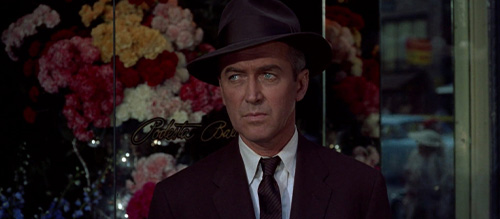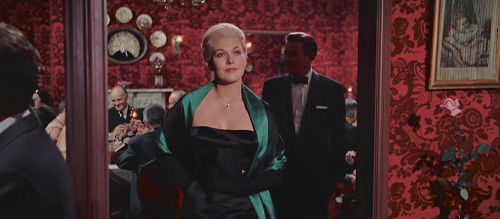‘Vertigo’ at 65 – Review

Vertigo (1958)
Director: Alfred Hitchcock
Screenwriter: Alec Coppel, Samuel A. Taylor
Starring: James Stewart, Kim Novak, Barbara Bel Geddes, Tom Helmore, Henry Jones
The name “Alfred Hitchcock” carries a level of prestige that makes it difficult to view his films with anything but an overwhelming weight of expectation. He has been praised as a master of the craft by most filmmakers and critics with any right to bestow such a title, and the breadth of films that can be traced back to him by a line of direct influence is astronomical. His 1958 film Vertigo is one that carries a particular weight of its own. In 2012 it was crowned number one in Sight & Sound’s prestigious critics poll, the Greatest Films of All Time list, ending a fifty-year reign of Orson Welles’ Citizen Kane and becoming only the third film to top the poll since its inception in 1952. Vittoria De Sica’s Bicycle Thieves was its inaugural champion.
If any one film can be used as an example of just how far and wide Hitchcock’s influence spreads, then Vertigo is a solid choice. Fans of David Lynch will notice a dreamy familiarity in Mulholland Drive, whereas Tommy Wiseau enthusiasts might find their ears perk up when a protagonist named Johnny asks a friend whose name begins with M how their love life is. The San Francisco backdrop also helps make the case that The Room was probably made with some reverence for Vertigo, even if it did turn out to be terribly different.
Starting with a situation that has since become a trope in its own right, we meet Johnny, played by James Stewart, who has just retired as a police detective following a traumatic incident which led to him finding out that he has acrophobia, an extreme fear of heights. There are a few dead giveaways of Vertigo’s age in its highly expositional dialogue – it is almost reminiscent of ‘Alfred Hitchcock Presents’, the director’s mystery anthology TV show. Midge (Barbara Bel Geddes) stands out early on as a character who is essential in highlighting Johnny’s flaws – she’s intelligent, supportive, and completely wasted on someone so self-centred and easily distracted by his own shortcomings.
An old college classmate, Gavin Elster played by Tom Helmore, asks Johnny, or Scottie as he’s known to his acquaintances, for help with a personal matter. His wife, Madeleine (Kim Novak), has been acting strangely lately, to the point that he’s starting to believe she may have been possessed by a dead family member, and he wants Johnny to follow her to find out what’s going on. It all goes wrong when the two find a special connection with one another.
Although upon release The Hollywood Reporter described Vertigo as “One of the most fascinating love stories ever filmed,” what it actually grows into is a story of blind obsession. Johnny doesn’t care about the woman in front of him nearly as much as he cares about his own idea of who that woman should be. The mastery of craft behind it begins to shine through in dialogue that becomes equally as brilliant as it is heartbreaking – it almost seems as if the early exposition exists to set our expectations at a level that allows us to be blown away later on.

As would be expected from a Hitchcock thriller, there are twists and turns that take the clues laid out in front of us to unusual heights. Although the term is associated with a more derogatory meaning since Martin Scorsese’s criticism of the superhero genre went viral, Vertigo is essentially a theme park movie. Everything exists to create an experience of shock and awe, but where it differs from the typical modern interpretation of how to achieve those emotions is that it appeals to them on an intellectual level. We have to take an active role in Vertigo because our thought processes about what’s happening are part of the narrative itself.
Perhaps that’s why Vertigo is so revered today. It exists in a space occupied by multiple forms of entertainment – it has the highs and lows of a rollercoaster, the audience participation of a magic show, and the love plot of a Danielle Steel novel – but it is also a tremendous piece of art in its own right.
Vertigo wasn’t always held on such a universal pedestal, though. Writing in The New Yorker upon the film’s initial release, John McCarten described it as “far-fetched nonsense”, and other magazines at the time were even more scathing in dismissing it as little more than fantastical dross. Even Sight & Sound’s editor, Penelope Houston, was fairly cold on it, writing that its plot was of “egg-shell thinness” and that “One is agreeably used to Hitchcock repeating his effects, but this time he is repeating himself in slow motion.”
Vertigo’s rise to a status that can command the top spot on the Greatest Films of All Time poll that she was instrumental in setting up is partly attributable to the reputation of Alfred Hitchcock as a filmmaker changing over the years. Although difficult to imagine now, he wasn’t always considered a serious artist. It wasn’t until the French New Wave movement, spearheaded by François Truffaut and Jean-Luc Godard, that Hitchcock began to be given the grace of a closer look. In drawing inspiration from his work and giving credit where it’s due, Hitchcock’s use of suspense, his focus on his characters’ psychological states, and his innovative camerawork were finally lauded as more than just consequential elements in throwaway entertainment.
Vertigo is therefore arguably Alfred Hitchcock’s greatest achievement on volume alone. Everything that could have been reassessed as Hitchcock the Auteur rather than just Hitchcock the Entertainer is present, and to a degree that makes it a perfect case study for how perception changes art.
Score: 21/24
Recommended for you: Top 10 Alfred Hitchcock Films
Written by Rob Jones
You can support Rob Jones on his website: rbrtjones.com
Twitter: @rbrtjones

